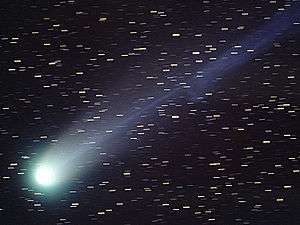Comet Zhu–Balam
| Discovery | |
|---|---|
| Discovered by | David D. Balam (June 8) and Gin Zhu (June 3) |
| Discovery date | June 3, 1997 |
| Orbital characteristics A | |
| Epoch | 1997-Aug-22 (JD 2450682.5) |
| Aphelion | ~2210 AU[1] |
| Perihelion | 4.899 AU |
| Semi-major axis | ~1100 AU[1] |
| Eccentricity | 0.9979 |
| Orbital period | 36,800 years (approx.)[1] |
| Last perihelion | November 22, 1996 |
Comet Zhu–Balam (C/1997 L1) is a long-period comet first identified by David D. Balam on June 8, 1997 and originally photographed by Gin Zhu on June 3, 1997.[2][3] The comet is estimated at 10 kilometres in diameter[3] with a period of approximately 36,800 years.[1]
Given the orbital eccentricity of this object, different epochs can generate quite different heliocentric unperturbed two-body best-fit solutions to the aphelion distance (maximum distance) of this object. For objects at such high eccentricity, the Suns barycentric coordinates are more stable than heliocentric coordinates. Using JPL Horizons the barycentric orbital elements for epoch 2015-Jan-01 generate a semi-major axis of 1100 AU and a period of approximately 36,800 years.[1]
References
- 1 2 3 4 5 Horizons output. "Barycentric Osculating Orbital Elements for Comet Zhu-Balam (C/1997 L1)". Retrieved 2011-01-31. (Solution using the Solar System Barycenter and barycentric coordinates. Select Ephemeris Type:Elements and Center:@0)
- ↑ "New comet named after astronomers". Canadian Broadcasting Corporation. November 13, 1998. Retrieved 1 February 2010.
- 1 2 McNeney, Mike (February 6, 1998). "Sharp-eyed Balam co-discovers comet". The Ring/University of Victoria. Retrieved 1 February 2010.


